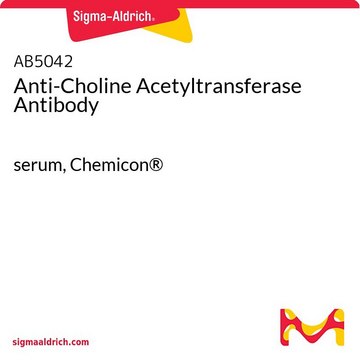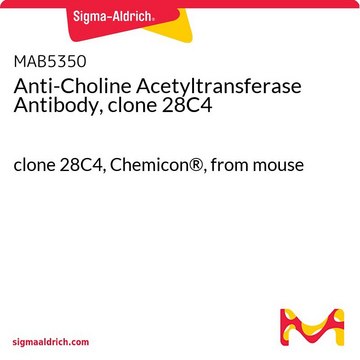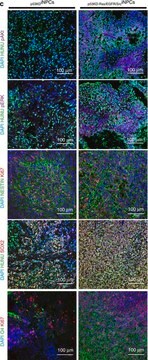MAB305
Anti-Choline Acetyltransferase Antibody
CHEMICON®, mouse monoclonal, 1E6
Synonim(y):
ChAT, Choline Acetylase, CHOACTase
About This Item
Polecane produkty
Nazwa produktu
Anti-Choline Acetyltransferase Antibody, clone 1E6, ascites fluid, clone 1E6, Chemicon®
pochodzenie biologiczne
mouse
Poziom jakości
forma przeciwciała
ascites fluid
rodzaj przeciwciała
primary antibodies
klon
1E6, monoclonal
reaktywność gatunkowa
human, rat, monkey
producent / nazwa handlowa
Chemicon®
metody
immunohistochemistry: suitable
izotyp
IgG1
numer dostępu NCBI
numer dostępu UniProt
Warunki transportu
dry ice
docelowa modyfikacja potranslacyjna
unmodified
informacje o genach
human ... CHAT(1103)
rat ... Chat(290567)
rhesus monkey ... Chat(709977)
Specyficzność
Immunogen
Zastosowanie
Optimal working dilutions must be determined by the end user.
IMMUNOHISTOCHEMISTRY PROCEDURE (PAP TECHNIQUE) FOR MAB305, MONOCLONAL ANTIBODY TO CHOLINE ACETYLTRANSFERASE
I) Perfusion & Sectioning Procedure
1. Perfuse through the heart with a fixative solution containing 4% paraformaldehyde in 0.12 M phosphate buffer (pH 7.3) for light microscopy (LM), and additionally, 0.1% gluteraldehyde and .002% CaCl2 for electron microscopy (EM).
2. Remove brain and postfix 2-18 hours at 4°C in 4% paraformaldehyde in 0.12 M phosphate buffer.
3. After brain is blocked for sectioning, wash in several changes of buffer for 2-3 hours.
4. Specimens for EM are sectioned on a Vibratome (50 μm) and rinsed in buffer, those for LM should be cryoprotected in 30% sucrose in buffer.
5. After freezing with dry ice, 30-40 μm thick sections of LM specimens are cut on a cryostat.
6. Sections are rinsed, and then stored in phosphate buffer containing 0.1% sodium azide.
II) Staining Procedure
Tissue is processed as freely-floating sections in continuously agitated solutions. All incubations are performed at room temperature unless otherwise stated.
1.a. For localizing ChAT-positive somata and dendrites:
Sections are washed in 0.1 M Tris-buffered saline (TBS; containing 1.4% NaCl, pH 7.3) only. No detergent or enzyme pretreatment is used.
b. For localizing ChAT-positive terminal-like structures:
Incubate sections in TBS (pH 8.1) for 5 minutes at 37°C. Transfer sections to TBS (pH 8.1) containing pronase (1.2 μg/mL) for 1 1/2-2 minutes at 37°C, followed by several ice cold buffer washes for a total of 5 minutes. The concentration of pronase and incubation time of the digestion should be evaluated for each region examined.
c. For localizing ChAT immunoreactivity and subsequently counterstaining the sections:
Incubation in TBS containing 0.1%-0.8% Triton X-100 for 15 minutes may increase the tissue penetration of the immunoreagents, but it also raises the background staining.
2. Incubate sections in normal goat serum (3-5%) for one hour. The working solutions of all antisera should also contain similarly diluted normal goat serum.
3. Incubate in anti-ChAT monoclonal antibody solution (Suggested working dilution 1:250, final working dilution must be determined by end user) for 2 hours at room temperature and then for an additional 6-18 hours at 4°C.
4. Incubate with second antibody (i.e. Goat anti-Mouse IgG, Cat. No.: AP124, dilution 1:50-100) for 1-2 hours.
5. Incubate with diluted PAP complex (i.e. Mouse PAP, Cat No.: PAP14, conc. 25-50 μg/mL) for one hour.
6. After rinsing in buffer, the second antibody and PAP steps are repeated for 40 minutes to 1 hour each in order to amplify staining intensity, particularly of small ChAT-containing structures.
7. React for 15 minutes with 0.06% 3,3′-diaminobenzidine×4 HCl (DAB; diluted in phosphate buffered saline, pH 7.3) and 0.006% H2O2.
8. Specimens for routine LM are postfixed for 1 minutes in 0.005% OsO4 (osmium tetraoxide), and then mounted, dehydrated and coverslipped. Selected regions blocked for EM are postfixed in 2% OsO4 for 1 hour, en bloc stained with uranyl acetate, and flat-embedded in Epon-Araldite resin.
Neuroscience
Neurotransmitters & Receptors
Neuronal & Glial Markers
Postać fizyczna
Przechowywanie i stabilność
Komentarz do analizy
Brain tissue
Inne uwagi
Informacje prawne
Oświadczenie o zrzeczeniu się odpowiedzialności
Nie możesz znaleźć właściwego produktu?
Wypróbuj nasz Narzędzie selektora produktów.
Kod klasy składowania
10 - Combustible liquids
Klasa zagrożenia wodnego (WGK)
WGK 1
Temperatura zapłonu (°F)
Not applicable
Temperatura zapłonu (°C)
Not applicable
Certyfikaty analizy (CoA)
Poszukaj Certyfikaty analizy (CoA), wpisując numer partii/serii produktów. Numery serii i partii można znaleźć na etykiecie produktu po słowach „seria” lub „partia”.
Masz już ten produkt?
Dokumenty związane z niedawno zakupionymi produktami zostały zamieszczone w Bibliotece dokumentów.
Nasz zespół naukowców ma doświadczenie we wszystkich obszarach badań, w tym w naukach przyrodniczych, materiałoznawstwie, syntezie chemicznej, chromatografii, analityce i wielu innych dziedzinach.
Skontaktuj się z zespołem ds. pomocy technicznej






